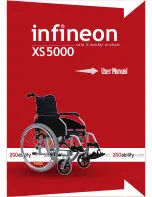
ANCHORAGES – FOLDING WHEELCHAIRS | USER MANUAL
NOTE: If you ignore these warnings or fail to inspect or maintain your wheelchair as directed in the manual, you may fall, tip over or lose control of the wheelchair and seriously injure yourself or others and damage the
wheelchair.
32
WARNING
A wheelchair compliant to the RESNA WC-
4:2017, Section 19 or ISO 7176-19:2019
standard must have both labels as shown
above. If any of these two pictograms are
not on the wheelchair, it cannot be consid-
ered as compliant to the standard.
WARNING LABEL
WARNING
Indicates a potentially hazardous condition/situation.
Failure to follow designated procedures can cause either
personal injury, component damage, or malfunction.
MANDATORY LABEL
MANDATORY
These actions should be performed as specified.
Failure to perform mandatory actions can cause personal
injury and/or equipment damage.
PROHIBITED LABEL
PROHIBITION
These actions are prohibited. These actions should not be
performed at any time or in any circumstances. Perform-
ing a prohibited action can cause personal injury and/or
equipment damage.
IMPORTANT LABEL
IMPORTANT
Indicates important information to remember when using
this product.
3. DEFINITION
ISO
International Organization for Standardization
ANSI
American National Standards Institute
RESNA
Rehabilitation Engineering and Assistive Technology Society of
North America
OCCUPIED TRANSIT ANCHOR KIT
A wheelchair-mounted kit that allows the wheelchair to be an-
chored in a motor vehicle.
Motion Composites' occupied transit anchor kit options consist
of four mounting brackets factory-installed on the wheelchair. In
some markets, the kits may be offered with an optional wheelchair
anchored pelvic safety belt. Always use this optional belt with the
vehicle anchored chest safety belt. If this option is not present,
always use the vehicle anchored three-point safety belt. NEVER rely
on a positioning belt during occupied transit. Only use the designat-
ed anchor points to secure the wheelchair to the vehicle.
WHEELCHAIR TIEDOWN AND OCCUPANT RESTRAINT SYSTEMS
(WTORS)
Equipments installed in a motor vehicle that allows a wheelchair
and/or its occupant in the wheelchair to be anchored in the motor
vehicle to restrict the movement of the occupant in case of a motor
vehicle accident. The equipment consists of a system or device for
securing the wheelchair and a belt-type restraint. Motion Compos-
ites occupied transit anchor kits are compatible only with four-point
strap-type tiedown systems.
ANCHOR POINTS
Specific structural points on the wheelchair base or seat frame that
are designed for attachment of a WTORS. These anchor points are
indicated by anchor points labels.
4. PROTOCOLS AND PROCEDURES
The wheelchair user should always transfer into the vehicle seat
and use the motor vehicle installed restraint system whenever
feasible. The wheelchair should then be stored and secured in the
vehicle. If the user deems it necessary to make a transit while occu-
pying the wheelchair, the vehicle must be equipped with wheel-
chair tiedown and occupant restraint systems (WTORS) previously
installed, in accordance with the manufacturer's instructions, and in
compliance with RESNA WC-4:2017, Section 19 or ISO 7176-19:2019
standard. The wheelchair must be equipped with the occupied tran-
sit anchor kit, in accordance with RESNA WC-4:2017, Section 19 or
ISO 7176-19:2019 standard. It is essential to use a complete WTORS
four-point strap-type tiedown and occupant restraint kit to secure
the wheelchair to the vehicle and provide the wheelchair occupant
with a safe and an approved restraint system.
The wheelchair tiedown and occupant restraint systems (WTORS)
must be used to protect the wheelchair occupant and minimize the
risk of injury due to contact with the vehicle during a collision or
sudden braking.
5. SECURING THE WHEELCHAIR
NOTE: In addition to following the general guidelines below, make
sure you follow all recommendations and instructions provided by
the WTORS manufacturer.
Always secure the wheelchair and occupant in a forward-facing
position in the vehicle.
Secure the four strap-type tiedowns only at the designated anchor
points. These occupied transit anchor points are indicated by an-
chor symbols on the wheelchair.
See figure 1and 2.
Figure 2
Anchor
Points
!
Figure 1. Anchor Points Location
FRONT OF VEHICLE









































